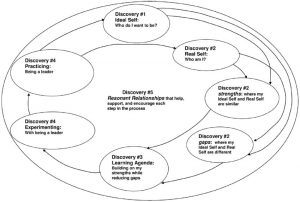As a professional coach, my first step in the coaching process is to establish a trusting relationship with the client, so they discuss their hopes and dreams openly and perceive a sense of safety to explore new thinking and behaviors. I use the proven methodology of coaching with compassion and the Intentional Change Theory (ICT) by Richard Boyatzis, distinguished professor of Organizational Behavior, Psychology, and Cognitive Science at Case Western Reserve University. Coaching with compassion is a process that aims to further the clients’ development by focusing on their Ideal Self and strengths. The clients will experience positive emotions and become more open to new possibilities, growth, and renew themselves. The guiding principle of this coaching style is to focus on the clients’ strengths more than their weaknesses.
As a human being, you are involved in an evolutionary process, where the most important ability is adapting to different circumstances. Human life is a process of change, through which you change body, environment, beliefs and way of thinking. Across these various levels of change, there is your identity, in terms of personal values, aspirations and professional choices. Boyatzis explains the process of change of human behavior through the Intentional Change Theory (ICT). This theory states that sustained, desired change occurs in a dynamic, non-linear process highlighted by five discoveries:
 Ideal Self: Who do I want to be?
Ideal Self: Who do I want to be?
- Real Self: Who am I?
Strengths: where my Ideal Self and Real Self are similar.
Gaps: where my Ideal Self and Real Self are different.
- Formulation of a learning agenda: building on my strengths while reducing gaps.
- Practice and experimentation with new behaviors.
- The support of resonant relationships.
At the beginning of the coaching process, I spend more time on the first discovery: the ideal self, namely one’s passion, purpose and core values, since this will set the direction to follow. The components of the Ideal self, along with a dream or desired image of the future, define your identity. These elements support your ability to craft your vision, fostering a sense of hope and acting as a catalyst. The ideal self is centered on self-motivation: what a person wants to do. The self-motivation and a focus orientation toward the future lead you to attain the desired outcome. According to the ICT theory, often you think you are pursuing an ideal self, but instead, you are pursuing what is described as an “ought self”. Boyatzis describes the ought self as an ideal self-imposed on you by others, or sometimes, by your own internal desire to please others. In other words, it represents who others think you should be or who you think you should be, rather than who you really want to be. These external expectations or projections might conceal your ideal self. It’s like when you lose your inner compass and decide to follow the suggestions coming from whom you trust more. The reason for that is that you believe that being compliant with the external world can make yourself and the people, you care about, happier and proud of you.
However, at a certain point, you might have a wake-up call and find yourselves feeling disappointed, frustrated, or even angry. The main reason is that you have wasted so much time and energy in your life pursuing something that was never really what you wanted. To recognize that you are entrapped in the ought self, you can see your life engaged in a process of conformity that is a kind of behavior you adopt to accomplish the external social requirements. It might be a mistake to lose your identity to conform to others’ expectations, not knowing your real dreams and aspirations and forfeit your vision.
If you recognize that you are in this process, what can you do to bring your attention back to the ideal self?
According to the ICT, getting in touch with the ideal self requires asking and then answering the question: who do I really want to be, and what do I really want to do with my life?
In my daily life, do I express myself, my talents, passions, and values as I really want to do?
Getting in touch with your ideal self will drive the generation of a personal vision that becomes the motivational force for realizing something meaningful. The development of a clear vision is a process through which, you learn to know yourself, abilities, talents, and aspirations. Holding a personal vision is the best way to face the several changes you experience during your life. Because, beyond every unknown circumstance, or moments of indecision about the next step, your vision leads you toward the desired destination. The coaching process will help you to have a clear vision of the desired future, especially your dreams and aspirations, as well as your passion and what you see as your calling or your purpose in life. Finding your uniqueness as an individual is a process of learning and discovery. It’s like a seed that needs the right conditions to grow and flourish. This five-stage discovery process will act as an overarching framework for your developmental experience.
Photo by Jen Theodore on Unsplash








